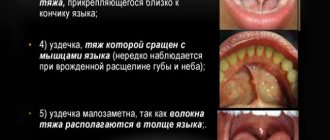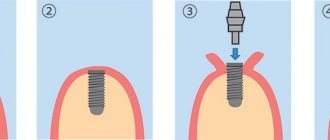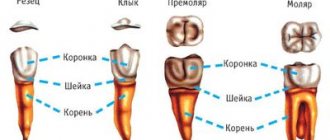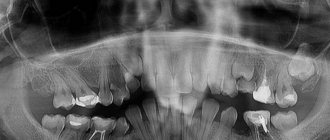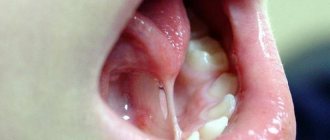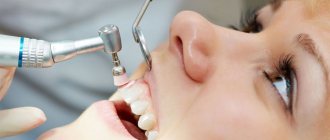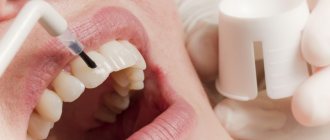Gingivoplasty - what is it?
Gingivoplasty is one of the types of surgical interventions in dentistry. The operation consists of eliminating pathological changes, as well as congenital defects of the gums in order to restore its aesthetic and functional state. To achieve results, the surgeon performs different types of manipulations:
- removal of hyperplastic tissue;
- extension of soft tissue in areas of recession;
- alignment of the gum contour;
- elimination of defects of the frenulum of the lips and tongue.
Gum plastic surgery can be performed using the classical method using a scalpel or using laser technology. The duration of the recovery period is 1-2 weeks.
Prices for gingivoplasty in Moscow
The cost of the procedure in Moscow clinics varies from 1500-2500 rubles per tooth. The cost per segment is 4500-6000 rubles.
As mentioned earlier, gingivoplasty using a laser will be slightly more expensive than using the patchwork method, its price is from 3,000 to 4,000 rubles per tooth, on average 10,000 to 12,000 rubles per segment.
If you still have any questions about this method of gum correction or any other topics, feel free to contact the LeaderStom clinic, our highly qualified specialists will help you decide on treatment and return you to a healthy and Hollywood smile.
Advantages and disadvantages of the procedure
Gingivoplasty can solve many gum problems and stop the development of serious diseases. But, despite numerous advantages, the technique also has negative sides.
| Advantages | Flaws |
|
|
Types of gum plastic surgery
- gingivoplasty - restoration of gum volume during its atrophy, that is, recession, or implantation;
- gingivotomy - dissection of the wall of the periodontal pocket to perform open curettage;
- gingivectomy - cutting off part of the overgrown gum in the presence of large gum pockets.
Indications
Gingivoplasty refers to aesthetic surgeries performed at the request of the patient for cosmetic purposes. But in a number of clinical situations, gum surgery is prescribed by a doctor for medicinal purposes. Main indications:
- inflammatory periodontal diseases, accompanied by the formation of periodontal pockets (periodontitis, hypertrophic gingivitis);
- gum pathologies, in which gum atrophy is observed (periodontal disease, fibromatosis, benign tumor-like neoplasms);
- gum augmentation during implantation to prevent rejection of the artificial root;
- hypertrophy of soft periodontal tissues;
- congenital frenulum defects;
- traumatic damage to the gums;
- age-related dystrophic changes in the gums;
- abnormalities in the development of the gingival margin (“gummy smile”, crooked contour).
Causes of gum abnormalities
Gingivitis, periodontitis, and periodontal disease are characterized by inflammation, hypertrophy or recession of gingival tissues, and the formation of periodontal pockets. In this case, the contours of the gum change; it either grows, covering the crown, or atrophies, exposing the roots. When periodontal pockets form with a large number of stones and granulomas, the edges of the mucous membranes become uneven.
Other causes of defect formation include congenital abnormalities, trauma during complex tooth extraction, and the formation of an uneven edge during implantation and prosthetics.
Contraindications
Gingivoplasty is an invasive procedure, so it cannot be performed in certain conditions:
- hemostasis disorders;
- severe somatic diseases;
- history of uncompensated diabetes mellitus;
- neoplastic processes;
- significant malocclusion;
- sensitization to drugs used during manipulation;
- active inflammation in the oral cavity;
- metabolic disorders;
- immunosuppressive conditions;
- acute respiratory diseases.
Step-by-step description of gingivoplasty
Gingivoplasty is performed on an outpatient basis in a dental operating room by a periodontist surgeon. A mandatory step before surgery is diagnostics, including:
- Gum plastic surgery after implantation
- blood testing (general clinical blood test with leukocyte formula, determination of hemoglobin concentration, coagulogram);
- ELISA for infections (HIV, syphilis, hepatitis);
- orthopantogram;
- ECG;
- consultation with narrow specialists (if necessary).
Before surgery, the patient must visit a dental hygienist and therapist (to sanitize the oral cavity). A few days before surgery, you should not take alcohol or blood thinners.
The surgical protocol depends on the patient's diagnosis. General scheme of gingivoplasty:
- Anesthesia. It is carried out with local anesthetic drugs. General anesthesia is rarely used.
- Disinfection of the surgical field.
- Excision of mucous membranes, formation of a flap.
- Carrying out the intervention in accordance with the chosen technology (flap surgery, gingivectomy, curettage, bone grafting, etc.).
- Treating the wound surface with medications.
- Aligning the edges of the wound, suturing.
A periodontal bandage is fixed over the sutures, which is removed only after 2-3 days. The duration of the manipulation is 1-1.5 hours. On days 5-7 after gingivoplasty, the patient is invited for a follow-up examination. The stitches are removed on the 10th day.
Gingivoplasty after implantation
Formation of gums after implantation of a titanium root is considered a mandatory procedure if its installation was carried out in place of a long-missing tooth. Gum recession in the implant area can lead to its loss or the addition of an infectious process.
To correct gum deficiency, patch technology is used. The autograft can be taken from the palate, cheek, and other areas of the oral mucosa. Gingivoplasty can be performed both during and after implantation.
Laser gingivoplasty
Most plastic surgeries in modern dentistry are performed using laser technologies. Instead of a classic scalpel, the surgeon uses a laser knife. Interventions carried out using this method have a number of advantages:
- Prevent the development of bleeding. The moment of incision is accompanied by simultaneous coagulation of tissues and blood vessels. The maximum blood loss during laser gingivoplasty is about 5 ml.
- Prevents infection from entering the wound. The operation is carried out without contact, so the introduction of pathogenic flora into the incision area is excluded.
- Provide maximum precision in flap excision. The absence of a human factor makes it possible to carry out cuts strictly according to the intended pattern.
- Guaranteed safety. The use of a laser prevents mechanical damage to nearby tissues.
The laser technique is less painful compared to conventional gingivoplasty. Wound healing occurs faster and less time is required for rehabilitation.
Why is it better to do gingivoplasty “in your sleep”?
If the patient is very afraid and worried about the upcoming operation, we suggest performing it under sedation. This is an immersion into a state of light sleep with the help of safe sleeping pills under the supervision of our experienced anesthesiologist.
Sleep therapy provides:
- Maximum comfort A person does not feel pain or experience emotional stress. Awakening is, as usual, quick and easy.
- High-quality treatment The doctor is 100% focused on the operation, eliminating the possibility of inaccurate actions due to random movements of the patient.
- Risk prevention The patient is not worried, the blood pressure is normal, the risk of bleeding, and therefore the formation of edema and hematomas, is lower.
- Improved healing There is no release of stress hormone, which reduces the immunological status and slows down the regeneration processes.
Features of postoperative care
The condition after gingivoplasty depends on the method of surgery performed, the volume of intervention, and the individual characteristics of the patient’s body. In the first 48 hours, hyperemia, swelling, and soreness of the gums may be observed.
- What is keratometry and how is it performed?
Minor bleeding is not a sign of pathology. If warning symptoms do not go away within 4-5 days, you should report them to your doctor.
The following recommendations will help speed up recovery:
- baths with an antiseptic solution should be performed every 3 hours (1-2 days after gingivoplasty);
- follow a special diet that excludes spicy, sour foods (the menu includes only pureed, soft dishes);
- During the rehabilitation period, completely eliminate alcohol and smoking;
- Perform oral hygiene procedures with care so as not to damage the sutures;
- use medications prescribed by the dentist (anti-inflammatory, analgesics, antibiotics);
- Visit the doctor for a follow-up examination at the appointed time.
How long does it take for gums to heal after surgery?
It may take 12-15 days for the gums to fully recover. Physiotherapeutic procedures will help speed up the process. They improve lymphatic drainage, reduce swelling, stimulate microcirculation, and accelerate tissue regeneration by normalizing trophism and gas exchange. For these purposes, the following physical methods are used:
- DENS (dynamic electrical neurostimulation);
- UHF;
- laser treatment;
- magnetotherapy.
If the surgeon’s recommendations are not followed, undesirable complications may occur:
- suture dehiscence, bleeding;
- addition of infection;
- tissue swelling;
- exacerbation of periodontitis;
- sepsis, etc.
How much does surgical treatment cost?
The cost of surgery to restore gums starts from 15,000 rubles. For creating an ideal contour around one tooth.
In case of significant bone deficiency, additional bone grafting may be performed. The decision to use this treatment method is made by the doctor based on the results of computer diagnostics.
The specialists of Dr. Lemberg Dental Clinic are waiting for you for a consultation, where you can see all the equipment used, get answers to all your questions and undergo a comprehensive diagnosis to draw up a comprehensive treatment plan. Doctors will make every effort to make your smile perfect.
Photos before and after
Negative dynamics after gingivoplasty are observed in no more than 3% of those operated on. Most cases have a positive prognosis. We offer a selection of photographs taken before and after gingivoplasty.
